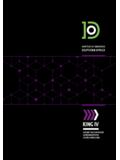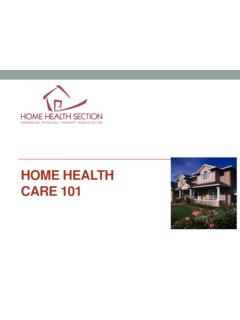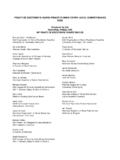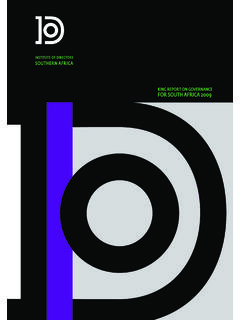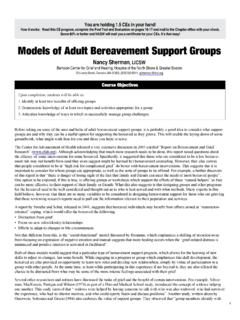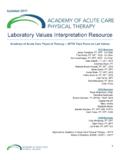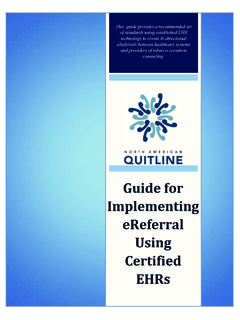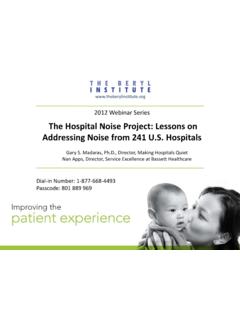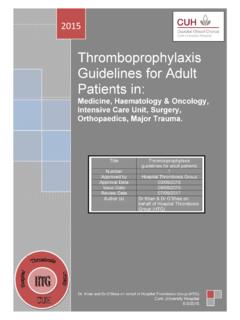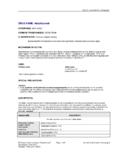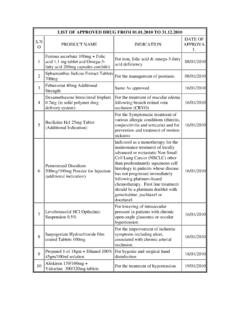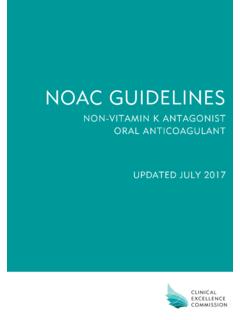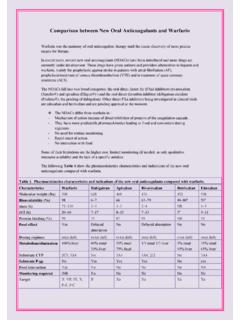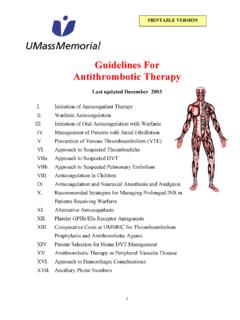Transcription of Acute Care Physical Therapy Practice and Clinical Practice ...
1 1 Acute Care Physical Therapy Practice and Clinical Practice guidelines Jim Smith, PT, DPT The National Guideline Clearinghouse (NGC) is a publicly available database of evidence-based Clinical Practice guidelines and related Updated weekly with new content, the NGC is produced by the Agency for Healthcare Research and Quality (AHRQ, formerly the Agency for Health Care Policy and Research [AHCPR]), in partnership with the American Medical Association (AMA) and the American Association of Health Plans (AAHP) Foundation. 1 The guidelines are developed through systematic processes for review of the literature, evaluation of the evidence, and vetting by AHRQ. Documented within each guideline are the methods used to search for evidence, the system used for evaluating the strength of the evidence and the strength of the Clinical recommendations.
2 Guideline currency is ensured by the removal of guidelines from NGC if the guideline has not been revised or updated within five years of publication. This comprehensive process ensures the guidelines are scientifically valid, unbiased, up-to-date and trustworthy. The information and recommendations in the guidelines should be used to inform decision-making by individual Physical therapists, and by teams of health care professionals working to improve outcomes within an institution or across systems. For example, the information in a guideline may be used to: Update or improve a clinician s approach to management of the problems encountered by patients with a specific pathology. Improve a clinician s understanding and appreciation of the strategies being used by other members of the health care team.
3 Educate and persuade other members of the health care team about the patient management strategies being recommended and used by a Physical therapist. Inform and provide current evidence for those who are developing system-wide policies and guidelines for patient care. There are thousands of Clinical Practice guidelines in the NGC. Following is a sample of guidelines that may interest the Acute care Physical therapist and Physical therapist assistant. To search for additional guidelines in the NGC go to: To set up a free account to receive notification of new and updated guidelines go to: General Medical: Orthostatic hypotension. Delirium: diagnosis, prevention and management Association for the Advancement of Wound Care guideline of pressure ulcer guidelines .
4 Pressure ulcer prevention and treatment protocol. Health care protocol. Association for the Advancement of Wound Care (AAWC) venous ulcer guideline. Exercise and type 2 diabetes: American College of Sports Medicine and the American Diabetes Association: joint position statement. 2 Management of hyperglycemia in hospitalized patients in non-critical care setting: an Endocrine Society Clinical Practice guideline. Diabetic foot problems. Inpatient management of diabetic foot problems. Depression in adults with a chronic Physical health problem. Treatment and management Management of overweight and obesity in the adult. Neurological problems in liver transplantation. Neuromuscular: Acute stroke management. In: Canadian best Practice recommendations for stroke care.
5 Cross-continuum topics in stroke management. In: Canadian best Practice recommendations for stroke care. Hyperacute stroke management. In: Canadian best Practice recommendations for stroke care. Managing stroke care transitions. In: Canadian best Practice recommendations for stroke care. Stroke rehabilitation. In: Canadian best Practice recommendations for stroke care. Rehabilitation. In: Clinical guidelines for stroke management 2010. Management of Alzheimer's Disease and Related Dementias Late (complicated) Parkinson's disease. Multifocal motor neuropathy. Paraneoplastic neurological syndromes. Post-polio syndrome. Use of imaging in cerebrovascular disease. Use of imaging in multiple sclerosis. Cardiovascular and Pulmonary: Nonpharmacologic management and health care maintenance of patients with chronic heart failure: HFSA 2010 comprehensive heart failure Practice guideline Post myocardial infarction: secondary prevention in primary and secondary care for patients following a myocardial infarction Chronic Obstructive Pulmonary Disease (COPD): Pulmonary Rehabilitation Prevention of venous thromboembolism.
6 Evidence-based management of anticoagulant Therapy : antithrombotic Therapy and prevention of thrombosis, 9th ed: American College of Chest Physicians evidence-based Clinical Practice guidelines . Falls: Prevention of falls ( Acute care). Health care protocol. Fall prevention guidelines . In: Promoting active living (PAL): best Practice guidelines for fall prevention in assisted living Falls and fall risk. Musculoskeletal: Hip fracture. The management of hip fracture in adults. Osteoarthritis. The care and management of osteoarthritis in adults Management and prevention of osteoporosis. Medical management of adults with osteoarthritis. 3 Evidence-based care guideline for return to activity after lower extremity injury in children and young adults ages 5 through 22 years.
7 Adult Acute and subacute low back pain. Neck pain: Clinical Practice guidelines linked to the International Classification of Functioning, Disability, and Health from the Orthopaedic Section of the American Physical Therapy Association. Osteoporosis: diagnosis, treatment, and fracture prevention. Oncology: Nutrition and Physical activity guidelines for cancer survivors. American Society of Clinical Oncology guideline: recommendations for venous thromboembolism prophylaxis and treatment in patients with cancer. Psychosocial health care for cancer patients and their families. American Cancer Society guidelines on nutrition and Physical activity for cancer prevention: reducing the risk of cancer with healthy food choices and Physical activity.
8 Reference: 1 Agency for Healthcare Research and Quality. The National Guideline Clearinghouse Fact Sheet. Accessed August 6, 2012.

